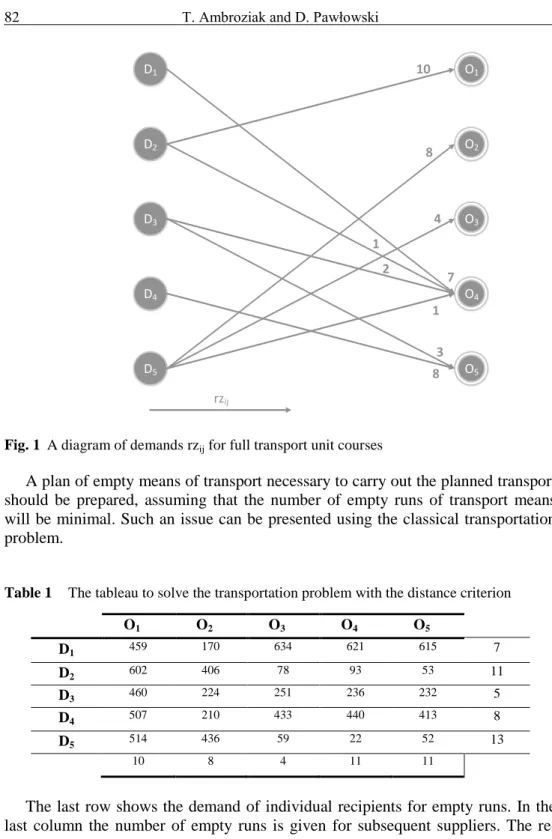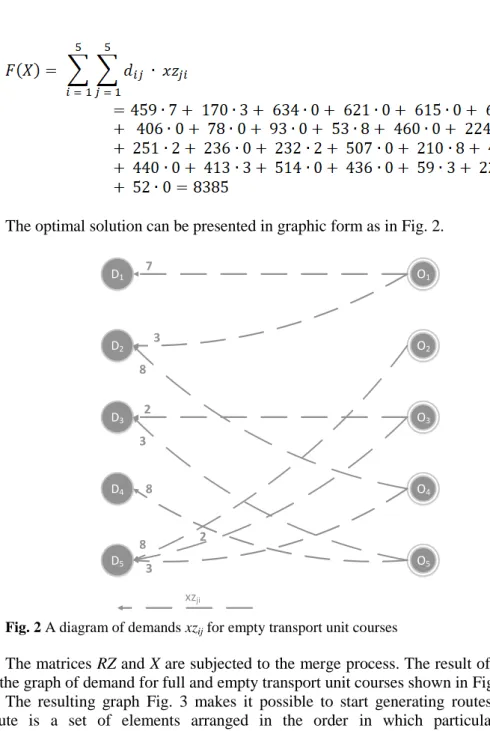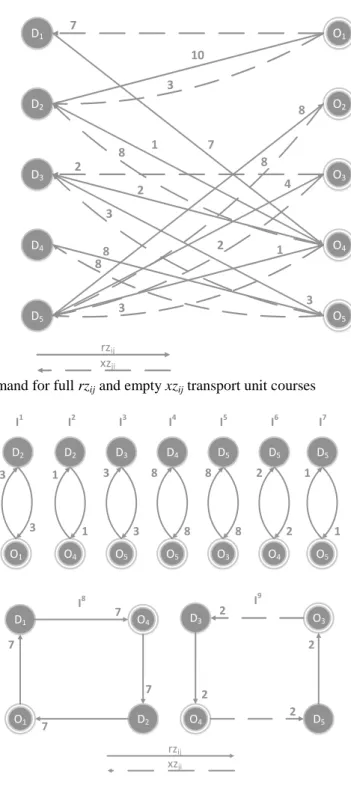MINIMIZATION OF EMPTY TRUCK RUNS.
FORMULATION OF PROBLEM
Tomasz Ambroziak* and Daniel Pawłowski**
* Warsaw University of Technology, Faculty of Transport, Warsaw, 00-662, Poland, Email: tam@wt.pw.edu.pl
** Air Force Institute of Technology, Warsaw, 00-662, Poland, Email: daniel.pawlowski1@gmail.com
Abstract The article formulates the issue of minimizing empty runs. Then, the interpretation of the issue of empty runs on numerical examples is presented. The formulation of the issue of minimizing empty runs requires the formulation of two optimization problems. The first one concerns distribution of commodities with minimal cost. The optimization problem formulated in this way is a well-known transport problem with the objective function being the costs of transport. The second one concerns commodity transport with distance minimization. After solving these two issues, the circulation problem of transport means is solved. Thanks to which we obtain the minimum number of empty runs expressed in distance units.
Paper type: Research Paper Published online: 15 April 2019 Vol. 9, No. 1, pp. 77–87
DOI: 10.21008/j.2083-4950.2019.9.2.2
ISSN 2083-4942 (Print) ISSN 2083-4950 (Online)
© 2019 Poznan University of Technology. All rights reserved.
Keywords: transportation problem, empty truck runs, graphs, optimization, routes and schedules
1. INTRODUCTION
Proper route planning and minimization of empty runs can significantly reduce costs and above all, increase the efficiency of the transport company. Empty runs, in the sense of unloaded means of transport, increase the cost of services and nega-tively affect the environment. This is an adverse phenomenon but unfortunately in-evitable. According to a report from 2017, published by the European Commission, approximately 23% of all truck runs in the EU were empty runs (European Commis-sion, 2017). Therefore, it is important to limit them to a minimum by optimizing routes planning, taking into account the minimization of empty runs with the full use of transport possibilities. The article formulates the optimization problem of deter-mining the minimum circuits of transport means. The input data necessary to formu-late the optimization problem is assumed. The decision variables and the analytical form of constraints at which routes are resolved in the sense of the given criterion function are determined. The model is based on Ambroziak & Żak (2004).
2. PROBLEM OF EMPTY TRUCK RUNS
2.1. Defined values
The demand for transport services will be expressed by a matrix with elements
zij. Which have interpretation of the demand for transport between the
distin-guished suppliers Di and recipients Oj where i = 1, 2, …, I and j = 1, 2, …, J.
Let the matrix Z with elements zij has the form (1):
Transport is considered within the area determined by cargo providers Di and
cargo recipients Oj. There is also a distance matrix dij between individual suppliers
It is obvious that adequate number of transport units of a certain type (all with the load capacity equal to q) should be used to meet transport needs.
Based on the matrix Z a matrix rzij for work courses can be easily created.
Ele-ments of the matrix Z can be expressed by the number of transport units (each with a capacity of q) necessary to transport the cargo between the suppliers Di and the
recipients Oj. In this case the matrix RZ with elements rzij has the form (3):
The elements of the above matrix can be expressed by the formula (4):
where element rzij is a number which has an interpretation of full cargo transport
from the supplier Di to the recipient Oj.
2.2. Searched values (decision variables of the empty truck runs)
Let the element xzji has an interpretation of the number of transport units that
should be in the recipient Oj for providing transport capabilities from the supplier
Di.
From the supplier Di has to leave (5):
loaded transport units.
In the same period of time to supplier Di has to arrive the same number of
empty means of transport. The following equation is met (6):
Similarly in the same period of time to the recipient Oj should arrive certain
loaded transport units, whereas the same amount of empty ones can therefore de-part from the recipient Oj. The second condition limiting the problem of empty runs
is the following statement (8):
The total number of kilometres completed by empty transport units will be (9):
From the above it follows that the problem of empty runs can be formulated as follows. The distance function should be minimized in the form (10):
subject to:
As it can be seen, the above problem is a typical linear programming problem, known in the literature as the transportation problem with the distance criterion. The solution to this problem (e.g. The Stepping-Stone Solution Method) is a matrix
2.3. Numerical interpretation of the issue of empty runs on numerical
example
Matrix Z is given and transport unit with a capacity of q = 2T.
From the above it follows that rz14 = 13 tonnes of cargo should be transported
from the supplier D1 to the recipient O4, similarly rz52 = 15 tonnes of cargo should
be transported from the supplier D5 to the recipient O2.
There is a distance matrix D between the suppliers Di and the recipients Oj (14).
It follows that the distance between supplier D1 and the recipient O5 is d15 = 514
kilometres. Analogously in other cases.
A matrix [rzij] containing a demand for full cargo transport is created using the
formula (15):
The demand for work courses can be presented in a graphical form as in Fig. 1. It follows that the number of working courses (with full load) from the supplier
D1 to the recipient O4 is rz14 = 7 transport units, six full courses (with q = 2T) and
one incomplete. Analogous interpretation for the remaining elements of the RZ matrix.
O1 D3 D4 D5 O2 O3 D2 D1 O4 O5 7 10 1 2 8 8 4 1 3 rzij
Fig. 1 A diagram of demands rzij for full transport unit courses
A plan of empty means of transport necessary to carry out the planned transport should be prepared, assuming that the number of empty runs of transport means will be minimal. Such an issue can be presented using the classical transportation problem.
Table 1 The tableau to solve the transportation problem with the distance criterion
O1 O2 O3 O4 O5 D1 459 170 634 621 615 7 D2 602 406 78 93 53 11 D3 460 224 251 236 232 5 D4 507 210 433 440 413 8 D5 514 436 59 22 52 13 10 8 4 11 11
The last row shows the demand of individual recipients for empty runs. In the last column the number of empty runs is given for subsequent suppliers. The
re-maining elements of the table contain distances between individual suppliers and recipients.
The objective function showing the number of empty runs of transport means that should be minimized takes the form:
subject to: = = = = = = = = = =
The optimal solution in the form of a matrix is obtained when the pre-sented transportation problem is solved.
The optimal solution can be presented in graphic form as in Fig. 2. O1 D3 D4 D5 O2 O3 D2 D1 O4 O5 7 3 8 2 2 8 3 3 8 xzji
Fig. 2 A diagram of demands xzij for empty transport unit courses
The matrices RZ and X are subjected to the merge process. The result of which is the graph of demand for full and empty transport unit courses shown in Fig. 3.
The resulting graph Fig. 3 makes it possible to start generating routes. Each route is a set of elements arranged in the order in which particular sup-plier/recipient will be visited by transport units moving along a given route. The route has a following property – the beginning of the route coincides with its end. Such routes in graph theory are called cycles.
O1 D3 D4 D5 O2 O3 D2 D1 O4 O5 7 10 1 2 8 8 4 1 7 3 3 8 2 2 8 3 3 8 xzji rzij
Fig. 3 The demand for full rzij and empty xzij transport unit courses
O1 D2 3 3 O4 D2 1 1 O5 D3 3 3 O5 D4 8 8 O3 D5 8 8 O4 D5 2 2 O5 D5 1 1 I1 I2 I3 I4 I5 I6 I7 O1 D2 D1 7 O4 7 7 7 D3 D5 O3 O4 2 2 2 2 I8 I9 xzji rzij
The optimal routes plan Fig. 4 which minimizes empty runs was determined us-ing the generated routes.
Taking into consideration e.g. route I8 from Fig. 4 it shows that from supplier
D1 7 full cargo transport will be departed to the recipient O4. Then from the recipient
O4 to the supplier D2 will be departed 7 empty means of transport. From the supplier
D2 7 full means of transport will be departed to the recipient O1. The last part of the
route i.e. from the recipient O1 to the supplier D1 will be departed 7 empty means of
transport. The other routes should be interpreted in the same way.
3. CONCLUSION
The results presented in this work were generated using proprietary computer software. The time needed to determine the optimal solution for large set of input data, using the algorithm discussed in the article, can be quite long. It follows that it is necessary to work on improving the algorithms, and more specifically on the speed of their operation in solving complicated problems. The next step would be to develop a specialized software package that would allow automatic visualization of the generated routes, based on Lipski (1989), Piasecki (1973), Schrijver (2003), Trzaskalik (2008).
The mathematical model presented in the article unambiguously confirms the validity of the optimization of empty runs. In the presented optimization problem, empty courses were reduced from 8443 to 8385 kilometres therefore the proposed approach is beneficial for reducing costs including transport, operation or mainte-nance.
REFERENCES
Ambroziak T. & Żak J. (2004) Metoda wyznaczenia optymalnej liczby środków transportowych dla realizacji określonego zadania transportowego, Wydawnictwo Politechniki Śląskiej, Gliwice.
European Commission – DG for Mobility and Transport (2017) An Overview of the EU Road Transport Market in 2015, available at: https://ec.europa.eu/transport/si- tes/transport/files/mobility-package-overview-of-the-eu-road-transport-market-in-2015.pdf (accessed 17 March 2019).
Kryński H. & Badach A. (1976) Zastosowania matematyki do podejmowania decyzji eko-nomicznych, Państwowe wydawnictwo naukowe, Warszawa.
Lipski W. (1989) Kombinatoryka dla programistów, Wydawnictwa Naukowo-Techniczne, Warszawa.
Piasecki S. (1973) Optymalizacja systemów przewozowych, Wydawnictwa Komunikacji i Łączności, Warszawa.
Schrijver A. (2003) Combinatorial Optimization. Polyhedra and Efficiency, Springer-Ver-lag, Berlin Heidelberg.
Trzaskalik T. (2008) Wprowadzenie do badań operacyjnych z komputerem, Polskie Wy-dawnictwo Ekonomiczne, Warszawa.
BIOGRAPHICAL NOTES
Tomasz Ambroziak is a Professor at Warsaw University of Technology, Faculty
of Transport.
Daniel Pawłowski holds a degree in Computer Science from the Rzeszow
University of Technology. He is a Senior IT Systems Architect at Air Force Institute of Technology, Warsaw, Poland. He is currently working on his Ph.D. thesis dealing with the optimization of empty truck runs.


